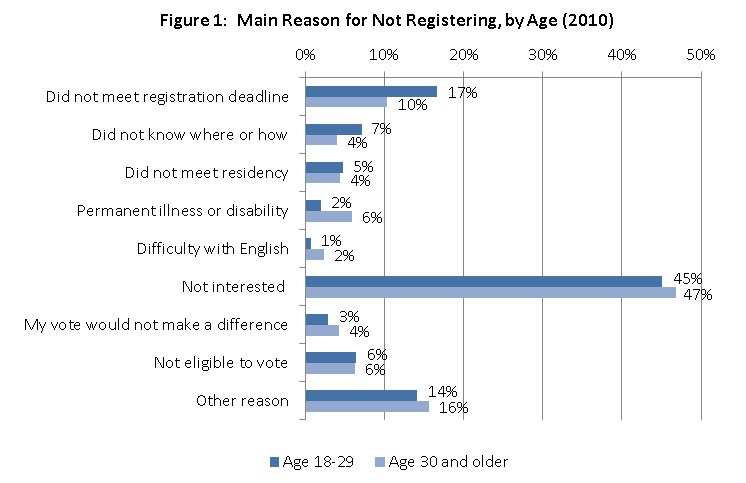2014 Midterms: Why Half of Youth Don’t Register to Vote
This is the third and final blog post in a series exploring aspects of youth voter registration in midterm elections. The analysis is based on this recently released CIRCLE Fact Sheet about young people’s electoral engagement in midterm years. Previous posts analyzed how youth register to vote and why many young people registered but did not cast a ballot in 2010. Today we discuss why some youth are not registered to vote and what that means for practitioners and offices working to increase their electoral engagement.
Less than half (49%) of young people, ages 18-29, were registered to vote in the 2010 midterm elections, a decrease of two percentage points from 2006 and the lowest registration rate for a midterm contest in the last two decades. That’s one of the highlights from our recent analysis of youth voter registration, which also explores why almost half of young people were not registered to vote in 2010, the election most comparable to this November’s upcoming midterm.
By far, the most common reason given by both youth and older adults (age 30+) for not registering to vote in 2010 was a lack of interest. It is worth noting, however, that contrary to the conventional wisdom that young people are apathetic or indifferent, they were actually slightly less likely (48% to 51%) to say that they were not interested or felt their vote would not make a difference.
The most significant disparity in why youth and older adults did not register to vote had to do with difficulties in the process. Nearly a quarter of young people (24%) said that they did not know where or how to register, or that they did not meet the registration deadline. For adults over 30, those two reasons accounted for only 14%. These data underscore the need to provide young people, many of whom are first-time voters, with accurate and timely information about the registration process.
This outreach will have even greater importance for the upcoming midterm election. Since 2011, states across the country have passed an increasing number of laws that restrict and often complicate the registration process. Our analysis of 2012 voting data found that these new policies especially affect youth. While there was no difference in the registration rate of adults 30 or older, in states with these restrictive laws 53% of youth were registered, whereas in states without these laws the registration rate was 59%.
Fortunately, the same appears to be true of policies, like same-day registration (SDR), that make voter registration easier and more convenient. The aggregated registration rate of young people living in states with SDR (63%) was six percentage points higher than the registration rate among youth living in non-SDR states (57%).
The marked effect of these policies on young people presents both challenges and opportunities for advocates and practitioners. Our analysis suggests that efforts to improve the electoral engagement of young people must include simple, convenient registration processes, and sharing concrete information about those processes with youth. It is also important to explore those “other” reasons for not voting in 2010 cited by almost 15% of young people. This is a substantial proportion of youth who may become engaged if their particular reasons for not registering to vote can be identified and addressed.
Check out our interactive youth voting map to find information about youth voter registration in your state, and double-click on your state to access a state-specific fact sheet. You can find an overview of youth voting here.






